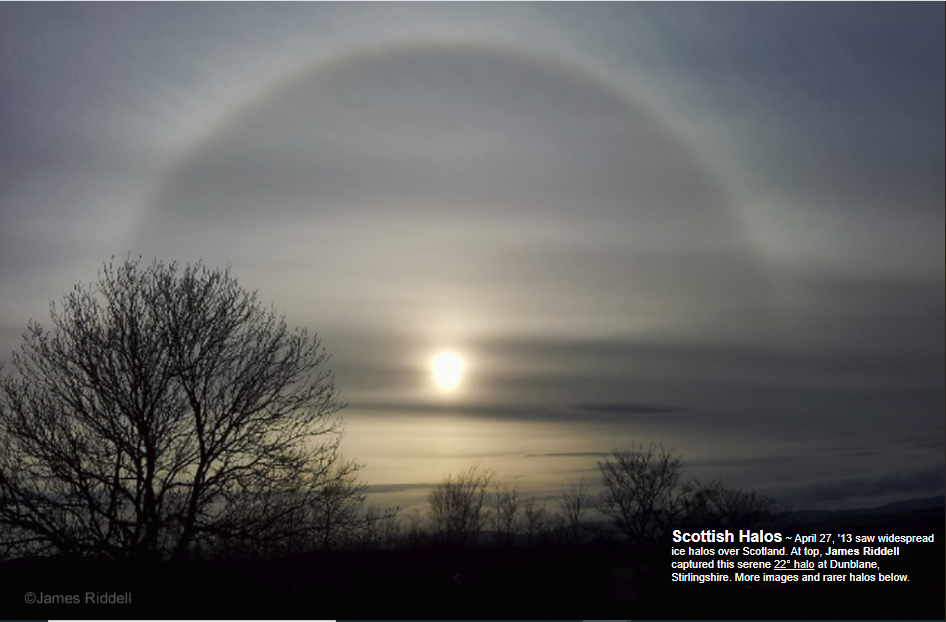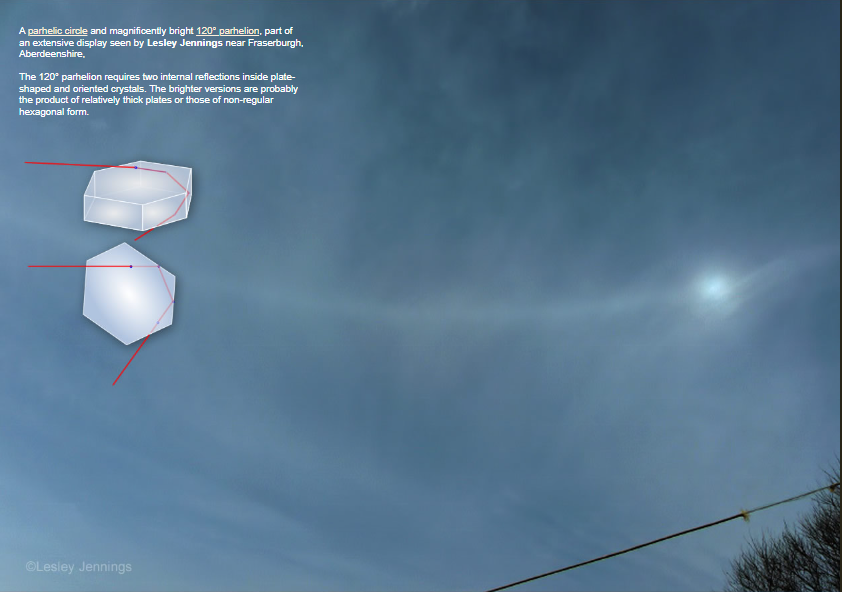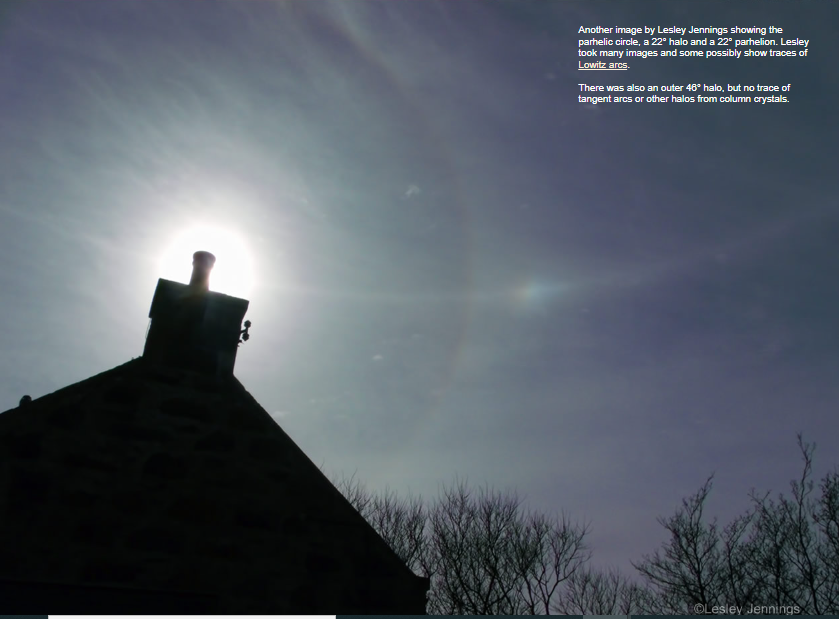OPOD - Scottish Halos
OPOD - Scottish Halos: A Spectacular Display of Atmospheric Optics
On April 27, '13, Scotland experienced a breathtaking phenomenon known as ice halos. These mesmerizing optical displays adorned the skies, captivating the attention of onlookers across the country. The enchanting images captured by photographers offer a glimpse into the wonder and beauty of atmospheric optics.
One of the remarkable images taken by James Riddell in Dunblane, Stirlingshire, showcases a serene 22° halo. This halo, formed by the refraction and reflection of sunlight by ice crystals in the atmosphere, encircles the sun with a halo-like ring. It is a common optical phenomenon observed when there are ice crystals present in the air.
Lesley Jennings had the opportunity to witness a more extensive display near Fraserburgh, Aberdeenshire. Her photograph reveals a parhelic circle and an incredibly bright 120° parhelion. The formation of a 120° parhelion requires two internal reflections within plate-shaped and oriented ice crystals. The brightness of the parhelion suggests the presence of relatively thick plates or non-regular hexagonal crystals.
In another captivating image by Lesley Jennings, we can see not only the parhelic circle and a 22° halo but also a 22° parhelion. These additional features add to the complexity and diversity of the atmospheric optics on display. Interestingly, some of Lesley's photographs possibly show traces of Lowitz arcs, which are faint arcs of light that can appear inside a halo.
Although the display included an outer 46° halo, there were no visible tangent arcs or other halos caused by column crystals. This highlights the variety of ice crystal shapes and orientations present in the atmosphere during this event. The absence of certain halos suggests that specific crystal types were less prevalent or absent altogether.
The occurrence of such stunning atmospheric optics phenomena is a result of the interplay between sunlight and ice crystals suspended in the atmosphere. As sunlight passes through these ice crystals, it undergoes refraction and reflection, leading to the formation of various halos, arcs, and circles. The size, shape, and orientation of the ice crystals determine the specific optical effects observed.
It is worth noting that this article has been automatically converted from the old website and may not appear as originally intended. However, the captivating images remain a testament to the awe-inspiring beauty of Scottish halos.
In conclusion, the widespread ice halos witnessed over Scotland on April 27, '13, provided a remarkable display of atmospheric optics. The photographs captured by James Riddell and Lesley Jennings showcase the diversity and intricacy of these optical phenomena. From the serene 22° halo to the bright 120° parhelion and possible traces of Lowitz arcs, these images offer a glimpse into the magic that unfolds in the skies above. The absence of certain halos suggests variations in ice crystal types and orientations. The interplay between sunlight and ice crystals in the atmosphere continues to astound and captivate observers, reminding us of the extraordinary beauty that exists in our natural world.

Scottish Halos ~ April 27, '13 saw widespread ice halos over Scotland. At top, James Riddell captured this serene 22° halo at Dunblane, Stirlingshire. More images and rarer halos below.

A parhelic circle and magnificently bright 120° parhelion, part of an extensive display seen by Lesley Jennings near Fraserburgh, Aberdeenshire,
The 120° parhelion requires two internal reflections inside plate-shaped and oriented crystals. The brighter versions are probably the product of relatively thick plates or those of non-regular hexagonal form.

Another image by Lesley Jennings showing the parhelic circle, a 22° halo and a 22° parhelion. Lesley took many images and some possibly show traces of Lowitz arcs.
There was also an outer 46° halo, but no trace of tangent arcs or other halos from column crystals.
Note: this article has been automatically converted from the old site and may not appear as intended. You can find the original article here.
Reference Atmospheric Optics
If you use any of the definitions, information, or data presented on Atmospheric Optics, please copy the link or reference below to properly credit us as the reference source. Thank you!
-
<a href="https://atoptics.co.uk/blog/opod-scottish-halos/">OPOD - Scottish Halos</a>
-
"OPOD - Scottish Halos". Atmospheric Optics. Accessed on November 25, 2024. https://atoptics.co.uk/blog/opod-scottish-halos/.
-
"OPOD - Scottish Halos". Atmospheric Optics, https://atoptics.co.uk/blog/opod-scottish-halos/. Accessed 25 November, 2024
-
OPOD - Scottish Halos. Atmospheric Optics. Retrieved from https://atoptics.co.uk/blog/opod-scottish-halos/.